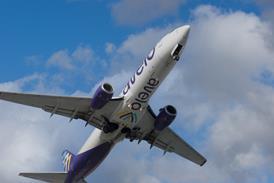The pooling of Bell and Agusta’s experience is proving to be a successful formula, says BAAC boss Lou Bartollota
After working together for more than 50 years, Bell and Agusta put their names to a joint venture that is now making significant inroads into the medium helicopter market with its first product, the AB139.

The all-new medium twin-turbine helicopter has accumulated more than 4,000h since entering customer service in March last year with “no significant operational issues”, says Lou Bartollota, managing director of the Bell/Agusta Aerospace (BAAC) joint venture.
BAAC will deliver 20 aircraft this year and plans to be producing 50 a year within two years on assembly lines in Italy and the USA. “Our objective was a 20-year production run of 1,000 units. At the rate we are taking orders, we will be well in excess of that,” says Bartollota.
The AB139 has come to market at a time when the civil helicopter industry is waking up from a long period of stagnation, and Bartolotta expects demand to remain strong for perhaps as long as 10 years. The underlying reason is the age of the existing fleet, he says, with perhaps 14,000 helicopters worldwide reaching a tipping point where, because of the cost of extending their service lives, operators are leaning towards replacing them with new machines. This is expected to result in a steady stream of orders.
BAAC believes the new technology in the AB139 tilts the balance in favour of buying new, because it offers performance, operability and safety levels beyond the older designs. And an orderbook in excess of 135 aircraft seems to bear out that belief. But the real test of the company’s faith in technology will come when it resumes active marketing of the AB139’s sister ship, the BA609 civil tiltrotor, certification of which has been pushed back to 2008.
Formed by Bell Helicopter and AgustaWestland in 1998, BAAC is far more of a partnership than the two companies’ earlier collaboration, which dates back to 1952 and involved licence-manufacture of Bell designs by Agusta. Although the AB139 was largely developed by Agusta, the Bell-designed BA609 is being tested and certificated jointly. To support the two aircraft in service, Bell and Agusta agreed to combine their best aftermarket practices, says Bartolotta.
Named managing director of BAAC in 2003, Bartolotta was formerly vice-president of marketing for AgustaWestland in Italy. With a background that includes flying Bell helicopters in the US military and the civil sector, and later marketing Agusta helicopters in the USA, he is familiar with both companies. “They have worked together for 53 years. They know each other,” he says.
The decision to co-operate in the medium rotorcraft sector has given both companies new products to sell, says Bartolotta. While AgustaWestland has responsibility for Europe, the Middle East and Africa, Bell has North and South America and Asia Pacific. The first US-assembled AB139 is due to roll off the assembly line at Bell’s Amarillo, Texas rotorcraft plant late in the first quarter of next year.
With a smooth entry into service under way, BAAC is focusing on expanding the AB139’s markets. Certification at an increased gross weight of 6.4t (up from 6t), and Category A operations at the higher weight, is due by year-end. Approval for elevated heliport operations is due the same time. The first AB139 for a US corporate customer, AIG, is in completion, and the aircraft is set to enter offshore operation with ChevronTexaco in the Gulf of Mexico.
The first emergency medical service (EMS) machine is just entering service, and Bartolotta sees potential sales of 50 or more aircraft in this market, noting: “There are a number of customers operating 412-sized helicopters – 75-80 aircraft – in the SAR/EMS market.” Another “intriguing mission” is the paramilitary sector, he says, including national police, border patrol and fisheries protection. “The AB139 has 4.5-5h endurance and can carry a lot of mission equipment. That could open the door.”
BAAC’s most pressing task is to ramp up production and bring down the lag between order and delivery from its current 34-36 months to a “more appropriate” 12-18 months. “We are in a tough spot. We could have 170 aircraft on order by the time we get to 50 a year, but we want to avoid a surge in production [to reduce the backlog] as that leads to overcapacity.”
Availability is also an issue with the BA609 tiltrotor and, despite “active customer interest”, Bartolotta does not expect to resume marketing before late 2006 or early 2007. Certification has slipped into 2008 and the company has a two-year production backlog of more than 60 orders that have to be fulfilled before delivery positions become available. “We are holding back for now,” he says.
The Bell/Agusta joint venture is coming to fruition with testing of the BA609, which achieved the milestone first conversion from helicopter to aeroplane mode in July. Two aircraft are now being assembled by AgustaWestland for flight tests from the fourth quarter. “Then you will see a remarkable thing – live data linkage between Italy and Texas,” says Bartollota. “Data collected in Italy will go to a common server, allowing the USA to pick up where Italy left off. Testing will be a continuum, not in parallel.”
After more than 50 years of working together, Bell and Agusta seem to have picked the right time and place to combine their names and their expertise. The true test of the venture’s strength is approaching as they ramp up production of the AB139, complete certification of the BA609 and support both types in service.
GRAHAM WARWICK/WASHINGTON DC
Source: Flight International























